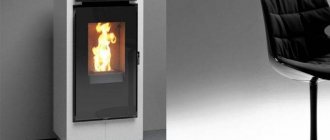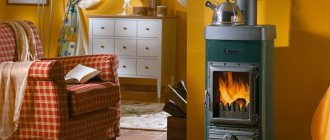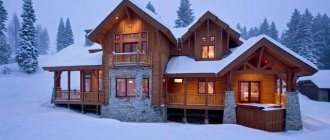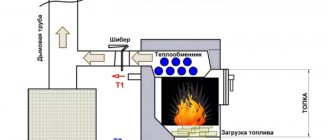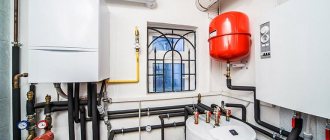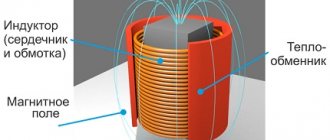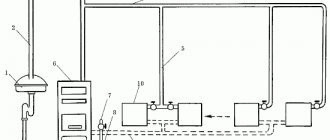Gas heating of a private home is the most common type of home heating in winter. “Blue fuel” is the most economical and accessible energy carrier, the combustion of which does not produce waste, soot or ash, or harmful emissions into the atmosphere.
The efficiency of modern gas boilers reaches 98%, which indicates the high efficiency of using this type of fuel. The level of gasification in various regions of Russia is 40-75% and is constantly growing. The interest of owners of country estates and dachas in gas heating equipment is increasing.
Types of gas fuel
Gas fuel for heating houses is supplied centrally through a main pipeline or supplied in liquefied form. To store it, special containers are used - gas tanks - with a volume of 5-10 m³, which are installed next to the house.
Natural methane gas is 4-5 times cheaper than liquefied gas. No refueling or complex equipment maintenance is required, as when using gas tanks. But, unfortunately, residents of not all regions have access to the highway. Then the use of sealed containers or cylinders is economically justified, since heating with diesel or electricity will cost 30-50% more. For autonomous heating, a mixture of propane and butane is used, which is stored in liquefied form at a pressure of 16 bar.
Advantages of gas heating
Gas heating of a private home is ahead of other heating systems in terms of:
- Price. Complete combustion of fuel contributes to the high efficiency of using this energy carrier. Some boilers use the energy released by condensing exhaust gases, increasing efficiency by up to 109%.
- Compactness. Modern gas boilers resemble wall-mounted furniture. They can be placed in the kitchen or in a small room. At the same time, the volume of the room is not lost, the interior is not overloaded with the type of equipment. There is no need to allocate space for storing firewood, coal or diesel fuel.
- Safety. Automatic devices monitor the operation of the system and remove burnt gases. At the slightest deviation from the norm, the flow of fuel into the combustion chamber is blocked.
- Economical consumption. Due to rising energy prices, boiler manufacturers are developing and constantly improving models that consume little but produce large amounts of thermal energy.
- Ability to regulate coolant temperature. As a result, resources are saved and comfortable conditions are created in every room.
Double-circuit gas boilers simultaneously heat the house and supply residents with hot water. In suburban farming conditions, this function is important.
Peculiarities
Gas heating is an object of increased explosion and fire hazard, therefore special services deal with all questions about connection and maintenance.
Before connecting the house to the gas main, a project for laying the line indoors and a diagram for powering the devices are drawn up. The documents are coordinated and approved by Gostekhnadzor.
The room where the gas boiler is installed is provided with good ventilation. For some models, a chimney is equipped, and a separate exit is arranged in the boiler room.
Boiler room in a private house
Boilers with forced exhaust gases are connected to the power supply system. To ensure that the equipment does not fail due to a sharp increase in pressure in the line, automatic adaptation is installed.
Important. In case of breakdowns or malfunctions in the operation of the boiler, you should seek help from specialists with a license to repair gas equipment.
What can gas heating be like?
The heating system in a private house includes:
- heat source;
- heat pipes;
- heating appliances.
The coolant that distributes energy from the source can circulate naturally or be pumped. To maintain the basic parameters of a given operating mode and remove burnt gases, sensors, valves, pumps and other automation are built into the system.
Based on the type of coolant, water and air heating are distinguished.
Definition and types
A combination boiler is a heating device that involves loading and processing two or more types of fuel materials; it may have two fireboxes, switching modes between them is carried out either automatically or manually. Based on the number of fuel types (gas, wood, coal and others), the boiler can be:
- standard;
- universal - implies the use of three or more types of fuel materials.
The unit may have hobs or burners. The complexity of installation and price directly depend on the configuration. A private house heated by such a boiler is guaranteed to receive not only heat, but also hot water. This is especially true in areas of the Far North, or other places that are difficult to reach for the benefits of civilization.
Water heating
The use of water as a coolant for heating began at the end of the 18th century. The French engineer Bonneman created a heated incubator with natural circulation of liquid. In Russia, until 1917, only rich people and apartment buildings could afford such a system. The rest of the residents used a wood or coal stove for heating.
Now water or chemical liquids are the most common coolant in heating systems of both apartment buildings and private houses.
Water has the highest heat capacity among all known substances - 4.18 J/gK. Slowly heating up, it also slowly releases energy to the surrounding space. This is the most efficient heat accumulator that smoothes out temperature changes on a planetary scale.
Water or antifreeze, heated by a gas boiler, moves through pipes to heating devices, where they transfer heat to the surrounding space through radiation. The process involves the transfer of energy by convection between heated layers of air.
Heating systems with liquid coolant are distinguished by:
- long service life;
- possibility of using different types of fuel in universal boilers;
- long-term heat retention in the room when the water in the radiators cools;
- uniform heating of batteries;
- simple maintenance.
Disadvantages of water systems:
- installation of pipelines and radiators is quite labor-intensive;
- during interruptions in work in winter, the pipeline may be damaged;
- in open systems where water evaporates in expansion tanks, regular replenishment is required;
- prolonged presence of water causes corrosion of metal parts and the formation of insoluble sediment;
- When pressure drops, air pockets form.
Some deficiencies can be eliminated by using distilled water or antifreeze. This leads to increased operating costs, but protects against breakdowns and leaks.
Air (convector) heating
In air heating systems, heat is transferred by convection. The air in the room is heated by special devices - convectors. Natural or liquefied gas during combustion is converted into energy without the participation of a coolant.
Convectors use sensors to maintain a given temperature in the room. The devices are equipped with a closed combustion chamber. Exhaust gases exit to the street through a coaxial pipe mounted in the wall. There is no smell in the room, the oxygen level does not decrease, which residents of private houses fear in vain.
Air heating is much more economical compared to traditional water heating. No pipe laying or coolant injection required. Energy is spent on heating the room, and is not lost when passing through the pipeline and heating radiators. Gas consumption - 0.13-0.51 m³/hour with a power of 2-10 kW.
Gas heating convectors
Gas heating convector
Gas convectors are essentially air heaters. The basis of the product design is a combustion chamber coupled with a heat exchanger. Gas burns in the chamber (open or closed type), air moves through the heat exchanger and acquires heat. It is worth noting that models with an open combustion chamber are quite rare - most often the intake of combustion air and the emission of combustion products is carried out using a built-in fan.
According to the mode of movement of heated air, equipment is divided into products with natural movement or with forced supply, realized using a fan (air). The materials for manufacturing heat exchangers of products are steel or cast iron; convector burners are of 2 types:
- Modulated (smooth power change);
- Unregulated - turn on and off according to the thermostat instructions.
Thermostats for controlling convectors are of mechanical and electronic types, and the latter are distinguished by more precise adjustment. Based on the principle of air distribution (giving it direction and supply sector to the room), products come in 2 varieties - with or without control elements (usually louvre type). Most gas convectors are dual-fuel - they can run on natural gas or liquefied hydrocarbon fuel (propane, butane).
According to the installation method, convectors are divided into 4 types:
- Wall-mounted (with power limitation to 10 kW);
- Floor-standing;
- Combined - can be placed on the walls or floor;
- Mobile (mobile).
The main advantages and disadvantages of gas series convectors are:
pros
- Lack of pipelines and heating devices;
- Lack of water – freezing and damage to equipment is excluded;
- Equipment with a closed chamber has virtually no effect on the quality of the microclimate of the heated room;
- Significant efficiency - up to 90%.
Minuses
- Only heating work is carried out - there is no possibility to produce hot water and connect other heat consumers;
- Quite uneven heating of rooms;
- Increased circulation of dust in a heated room;
- Most often, the rather large dimensions of the equipment limit the conditions for its placement.
Gas heating schemes for a house
A gas heating scheme for a private house is developed in order to properly organize the heating of all rooms, minimize costs and optimally use the power of the heating boiler.
Hot water circulates through the pipes, obeying the natural laws of physics. First, in a heated form, it rises along the riser, then, after cooling in the radiators, it returns to the collector and is sent to the boiler. The movement of liquid is caused by the difference in hydrostatic pressure between the columns of hot and cold water. This system is called gravity and is used where heating devices are located vertically on floors.
In private houses with a bottom water supply or horizontal distribution across floors, forced circulation of the coolant is used with pumping. This equalizes the temperature in the radiators, consumes less boiler power, and uses thinner diameter pipes.
Choosing a gas boiler for autonomous heating of a private house
In the past, atmospheric gas boilers were common, but recently the demand for them has begun to fall. They cannot be compared with modern fan-driven and condensing boilers.
The popularity of condensing boilers - the most technically advanced type of gas heat generators - is gradually increasing. True, not so fast: its growth is slowed down by novelty and a relatively high price.
Fan boilers are in greatest demand. They are more economical, more convenient and safer than atmospheric boilers and at the same time somewhat cheaper than condensate boilers. In other words, they have an optimal price-quality ratio.
